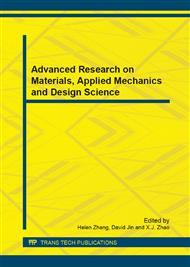[1]
D. J. Linse, R. F. Strengel. Identification of aerodynamic coefficients using computational neural networks. Journal of Guidance, Control and Dynamics, 16(6), (1993), 1018-1025
DOI: 10.2514/3.21122
Google Scholar
[2]
Y. B. Meng, J. H. Zou, X. S. Gan, et al., Research on WNN aerodynamic modeling from flight data based on improved PSO algorithm. Neurocomputing 83, (2012), 212-221
DOI: 10.1016/j.neucom.2011.12.015
Google Scholar
[3]
N. K. Peyada, A. K. Ghosh. Longitudinal aerodynamic parameter estimation using neural network and Gauss Newton method. Journal of Aerospace Sciences and Technology, 61, (2009), 295-304
Google Scholar
[4]
R. V. Jategaonkar. Flight vehicle system identification: a time domain methodology. Progress in Astronautics and Aeronautics Series, 1st Edition, AIAA, (2006)
Google Scholar
[5]
R. Kumar, R. Ganguli, S. N. Omkar and M. V. Kumar. Rotorcraft parameter estimation from real time flight data using radial basis function networks. Journal of Aircraft, 45 (1), (2008), 333-341
DOI: 10.2514/1.32024
Google Scholar
[6]
S. Singh, A. K. Ghosh. Parameter estimation from flight data of a missile using maximum likelihood and neural network method. Proceedings of AIAA Flight Mechanics Conference and Exhibit, (2006), 21-24
DOI: 10.2514/6.2006-6284
Google Scholar
[7]
R. Malmathanraj, S. S. Thamarai and E. Mahendran. Prediction of aerodynamic Characteristics Using Neural Network. Asian Journal of Information Technology, 7(1), (2008), 19-26
Google Scholar
[8]
M. E. Tipping. Sparse Bayesian learning and the relevance vector machine. Journal of Machine Learning Research, 1(3), (2001), 211-214
Google Scholar
[9]
C. M. Bishop, M. E. Tipping. Variational relevance vector machine. Proceedings of the 16th Conference on Uncertainty in Artificial Intelligence, (2000), 46-53
Google Scholar


